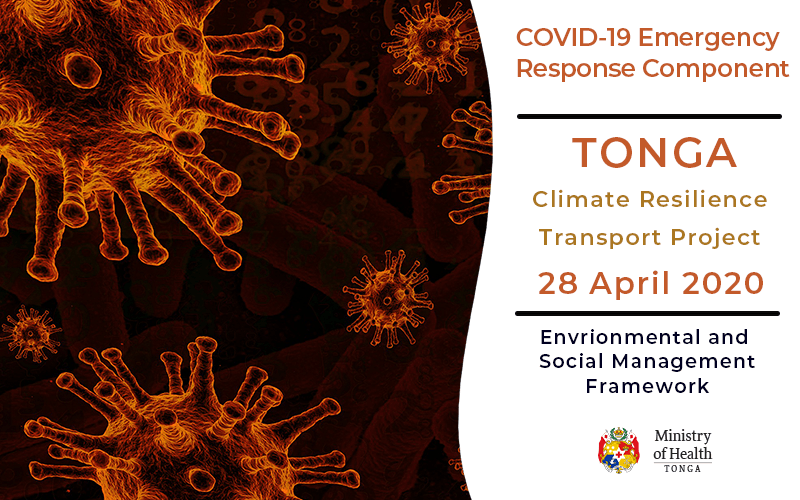COVID-19 Emergency Response Component

Background
The Kingdom of Tonga (Tonga) consists of 169 Islands, 36 of which are inhabited, and a total population of around 107,0001. The country lies in the South Pacific and stretches over a distance of approximately 800 kilometres (kms) from north to south, covering a total land area of 748 square kms with an Exclusive Economic Zone (EEZ) of about 700,000 square kms. Around three quarters of the population are based on the main island of Tongatapu, while other major islands and island groupings include Eua, Ha’apai, Vava’u and the Niuas Islands. Tonga’s location makes it one of the most geographically remote nations in the world from major centres of economic activity.
Extreme poverty across Tonga is negligible, but significant numbers live in hardship. Gross Domestic Product (GDP) per capita is US$ 5,320 at 2016 Purchasing Power Parity (PPP). According to preliminary estimates from the 2015/16. Household Income and Expenditure Survey (HIES), 0.95 percent of the population live with less than US $1.90 per day, with poverty in male headed households (0.97 percent) marginally higher than in female headed households (0.89 percent). While there are very few people in abject poverty in Tonga, “hardship” or lack of cash for basic goods is typically a more widespread concern. Rural populations are more likely to live in poverty than those in urban areas.
The potential for high economic growth in Tonga is constrained by inherent high cost structures. Over the past two decades, per capita GDP has grown by 1.1 percent per year, compared to 2.3 percent globally. This is marginally above the average for the group of small Pacific islands, which on average grew at 0.9 percent over the same period, though lower than any other region across the globe. Small size and remoteness combine to push up the cost of economic activity in Tonga, limiting the competitiveness of its goods and services in world markets. A high dependence on imports also renders the archipelago vulnerable to external economic shocks, such as food and fuel price spikes.
An outbreak of COVID-19 caused by the 2019 novel coronavirus (SARS-CoV-2) has been spreading rapidly across the world since December 2019. On March 11, 2020, the World Health Organization (WHO) declared a global pandemic. Similarly, the Government of Tonga on March 20, 2020 declared at state of emergency because of the risks of COVID – 19. As of April 14, 2020, the COVID-19 global outbreak has resulted in an estimated 2,019,320 confirmed cases and 119,483 deaths in 213 countries1. Tonga remains one of the less than 20 countries without a confirmed COVID-19 case, but the risks are high that COVID-19 could spread widely and rapidly, should the disease reach the country.
The global COVID-19 outbreak, if it reaches the Kingdom of Tonga, would place considerable constraints on an already challenged health system and cause possible loss of life. Health Services in Tonga are largely publicly funded and delivered by the Ministry of Health (MOH) through a network consisting of one National Referral Hospital, three outer- islands hospitals, and 24 lower level facilities. The Vaiola National Referral Hospital is a 200- bed facility based in the capital city Nuku’alofa, which is on the kingdom’s main island, Tongatapu. Seventy three percent of the population of Tonga lives on Tongatapu and roughly a third (35%) of the population live in the greater Nuku’alofa area. Significant disruptions in global and regional supply chains, higher prices, and economic losses in Tonga’s market countries will also be felt internally as Tonga relies heavily on imported goods and services. Border closures and travel restriction are also significantly affecting the tourism industry, which Tonga’s economy relies on. Most Tongan businesses are small and medium-sized enterprises, which are especially vulnerable to economic disruptions. Given the current outbreak of COVID-19 pandemic worldwide, the Government of Tonga (GOT) has effectively closed its borders to prevent the virus from entering the country.
Tonga currently has limited ability to prevent, detect and control a COVID19 outbreak. To prepare the country for a possible outbreak of COVID-19 the GOT and World Bank (WB) have activated Component 4 of the GOT, Tonga Climate Resilience Transport Project (TCRTP – P161539) - the Contingency Emergency Response Component (CERC) to immediately assist to reduce the impact of the health crisis and strengthen the health sector. The TCRTP PMU has developed on “Operations Manual for the Contingency Emergency Response Component 4” (March 2020). Additionally, an Emergency Action Plan (EAP) has been developed to assist, manage and direct the activities proposed under the CERC. The COVID-19 pandemic is a unique emergency that is not covered in the TCRTP CERC Environmental and Social Management Framework (ESMF) (July 2018). This document sets out the required safeguards to update the TCRTP CERC ESMF acknowledging the unique requirements of the COVID-19 emergency.
Project Description
In response to the COVID-19 pandemic, the GOT has requested the WB to trigger the CERC under TCRTP and allocate approximately US$ 2.5 million from unallocated funds in the project to strengthen Tonga’s health systems.
The specific activities to be financed by the proceeds allocated to the CERC are event and demand driven and the following eligible activities are coordinated and implemented in accordance with WB and the Tonga National Health Strategic Plan and the COVID 19 National Action Plan (MOH, 2020).
Reference
Click link below to download: Tonga Climate Resilience Transport Project 28 April 2020
